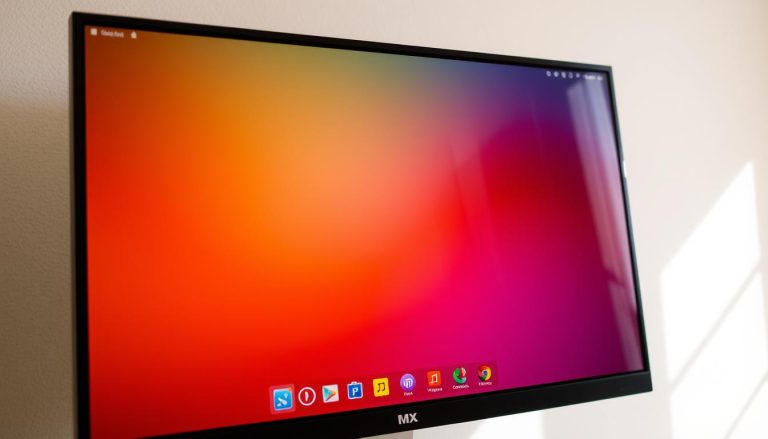Do you have an older computer gathering dust because modern software overwhelms it? Many believe such machines are destined for the scrap heap. But what if you could unlock new life from that aging hardware? We introduce a specialized type of operating system designed for efficiency. These systems run smoothly on computers with limited RAM, slow processors, and small storage drives. They strip away unnecessary components to deliver a responsive experience.
These efficient operating systems have become incredibly relevant. Users adopt them to revive older machines and reduce system bloat. The goal is to achieve faster performance, even on modern hardware, by focusing on essential functions.
This approach serves multiple purposes. It extends the lifespan of aging computers. It creates efficient environments for users who value speed over fancy visual effects. It also offers strong alternatives to resource-heavy systems.
Key Takeaways
- Specialized operating systems designed for low-resource hardware.
- Ideal for reviving older computers and reducing electronic waste.
- Deliver faster performance by minimizing unnecessary software.
- Provide efficient alternatives to resource-intensive operating systems.
- Selection depends on hardware specs and user experience level.
- Many offer full functionality despite their minimal footprint.
- Practical for dedicated tasks like programming or web browsing.
Primary use cases include repurposing legacy hardware. This hardware often cannot run current versions of major operating systems. These distributions are perfect for creating dedicated systems for specific tasks. They also help reduce electronic waste by keeping functional computers in service.
Our guide will explore the historical development of these efficient systems. We will examine their core features and benefits. We will also review top options available today, including insights from a comparison of lightweight Linux distributions. You will find practical guidance for selecting the right fit.
While these systems prioritize efficiency, they do not sacrifice functionality. Many include carefully curated software selections. They also offer access to extensive repositories for additional applications, as seen in options like Lubuntu.
Choosing the right distribution depends on your individual needs. Consider your hardware limitations and experience level. Think about your desired desktop environment. We will help you navigate these choices throughout this article.
Overview of Lightweight Linux Distros
Operating systems designed for minimal resource consumption have a rich history that spans multiple computing eras. We trace their development from early innovations to current applications.
Historical Context and Evolution
The evolution of efficient operating systems began in the early 1990s. Distributions like Slackware, created in 1991, established core principles of simplicity that influence modern approaches.
Puppy Linux emerged over 15 years ago as a pioneering distribution. It demonstrated that full-featured environments could operate directly from system RAM, requiring minimal hardware resources.
Crunchbang, though discontinued in 2013, left a significant legacy. This Debian-derived system spawned successors like BunsenLabs, continuing its philosophy of smartly configured window managers for blazing fast performance.
Relevance for Modern and Legacy Systems
These efficient systems have growing importance for contemporary users. Many seek alternatives to resource-heavy operating systems that prioritize speed over visual complexity.
They extend the lifespan of legacy hardware effectively. As mainstream operating systems demand more powerful specifications, older machines benefit from streamlined environments that deliver responsive performance.
The environmental benefits are substantial. By keeping functional computers in service, these distributions reduce electronic waste and make computing accessible across economic boundaries.
Understanding what is a lightweight linux distro
Efficient computing begins with understanding how software interacts with hardware limitations. We define these specialized operating systems as distributions engineered for minimal resource consumption.
Definition and Core Concepts
These systems achieve efficiency through careful component selection. They typically use streamlined window managers instead of full desktop environments.
Modular architectures load only necessary services, while optimized kernels reduce system overhead. This approach delivers significant performance gains on constrained hardware.
Why Users Choose Lightweight Options
The decision extends beyond reviving old hardware. Many users prefer the simplicity and faster boot times these distributions offer.
Different options serve various needs. Beginners appreciate straightforward interfaces, while experienced users value customizable foundations.
Selecting the right distribution requires analyzing your specific requirements. Consider your hardware compatibility and desired software availability.
Key Features and Benefits of Lightweight Linux Environments
Efficiency-focused systems deliver tangible benefits that transform the computing experience. We explore how these optimized platforms achieve remarkable performance gains.
Performance and Resource Efficiency
Streamlined systems boot in under 30 seconds, offering immediate responsiveness. Application launches occur instantly without frustrating delays.
Memory consumption remains minimal, leaving more RAM available for active tasks. Systems like antiX operate smoothly with just 256MB of memory.
Reduced CPU usage extends battery life significantly on portable devices. This efficiency allows older hardware to handle modern web browsing and media playback.
Customized Desktop Environments
These platforms employ window managers like IceWM and Fluxbox instead of heavy desktop environments. The LXQt desktop used by Lubuntu provides essential functionality without graphical overhead.
Customization tools like antiX’s control panel let users modify themes, menus, and system behaviors through centralized interfaces. Zorin OS Lite offers layout options that mimic Windows for easier migration.
Peppermint OS includes the ICE utility, transforming websites into desktop shortcuts. Despite minimal default configurations, these environments support extensive personalization through themes and keyboard shortcuts.
Product Roundup: Top Lightweight Linux Distros
The landscape of efficient operating systems offers diverse solutions tailored to different computing scenarios. We examine several standout options that excel in specific use cases.
Distros for Reviving Older Machines
antiX stands out for extremely limited hardware, running smoothly on systems with just 256MB RAM. Its IceWM window manager and systemd-free architecture deliver remarkable performance.
Lubuntu provides Ubuntu reliability on aging computers. The LXQt desktop environment requires minimal memory while maintaining access to Ubuntu’s extensive software repositories.
Options Tailored for Windows Users
Linux Lite features an Xfce desktop that mimics Windows layouts for easier transition. It includes familiar applications like Google Chrome and specialized tools for performance optimization.
SliTaz offers exceptional compactness with Openbox window management. This distribution can install directly from Windows without partitioning, ideal for testing purposes.
Specialty Distros with Unique Interfaces
Puppy Linux has over 15 years of development history with versions based on different foundations. It includes unconventional but practical applications alongside parent distribution compatibility.
Tiny Core Linux represents the ultimate minimalist approach. Available in three variants, it starts from just 17MB without GUI, expanding through modular package management.
Comparing Lightweight and Traditional Linux Distributions
The gap in system specifications between different types of distributions highlights contrasting approaches to computing. We examine how these choices impact everything from hardware compatibility to daily user experience.
Differences in Hardware Requirements
Hardware demands vary dramatically between these categories. Mainstream operating systems like Windows 10 typically require 4GB RAM for acceptable performance. In contrast, efficient alternatives operate with significantly fewer resources.
antiX demonstrates remarkable efficiency by running smoothly on just 256MB RAM. Lubuntu requires only 500MB, while Linux Lite needs 1GB. These differences show how architectural choices fundamentally shape resource consumption.
Traditional distributions often consume 10-20GB of disk space with bundled applications. Streamlined options may occupy just 2-5GB by including only essential software. This approach allows users to add specific packages as needed.
Software, Tools, and Interface Customization
Software selection philosophies diverge significantly. Traditional distributions provide extensive preinstalled application suites covering every conceivable use case. This ensures immediate productivity but increases system footprint.
Efficient alternatives include minimal default software—typically just a browser, text editor, and file manager. Users customize their installation by adding only necessary tools from repositories. This approach works well with container technologies like Docker Desktop.
Interface customization approaches also differ. Traditional distributions offer polished, cohesive desktop experiences with limited structural modification expected. Efficient alternatives frequently employ modular window managers that provide maximum flexibility.
Users can configure menus, panels, keybindings, and visual themes precisely to their preferences. This modular approach avoids predetermined limitations while maintaining system responsiveness.
Optimizing Your System with a Lightweight Linux Setup
The installation phase presents crucial opportunities for maximizing system performance. We guide users through essential preparation and configuration steps.
Installation Tips and Best Practices
Always begin with a test drive using live media. Distributions like BunsenLabs and Lubuntu offer this feature. It lets you verify hardware compatibility before committing.
For multi-boot setups, Linux Lite provides excellent support. Tools like Q4OS’s Windows installer simplify the process. They reduce technical barriers for new users.
Consider your installation media carefully. Porteus runs entirely from removable devices. Other options install directly to hard drives for persistent use.
Tools for Customization and Performance Tuning
These environments include powerful configuration tools. antiX features a home-grown control panel. It simplifies system adjustments without command-line complexity.
Performance tuning strategies include enabling zRAM compression. This improves responsiveness on memory-constrained hardware. Disabling unnecessary startup services also helps.
Evaluate your software needs incrementally. Install only essential applications initially. Add others as requirements emerge from available repositories.
Desktop profilers like Q4OS’s tool customize installations based on intended use. Appearance managers adjust UI elements for optimal workflow.
Conclusion
Your computing experience should reflect your unique workflow and hardware capabilities rather than following generic recommendations. We emphasize that selecting the ideal distribution represents a personal journey.
Key factors include your technical comfort level, specific hardware constraints, and desired software ecosystem. Community support quality and available documentation also significantly impact your success.
Beyond performance gains, these efficient systems deliver environmental benefits by extending hardware lifespan. They reduce electronic waste while maintaining functional computing access across economic boundaries.
Your preferences will naturally evolve as you gain experience and encounter new requirements. View your initial choice as a starting point for exploration rather than a permanent commitment.
We encourage testing multiple options using live USB media before installation. This approach helps you find the perfect balance of performance, functionality, and interface design. Some users may prefer mastering the command-line interface for maximum control.
The best choice remains the platform where you feel most productive and comfortable. Whether prioritizing familiar interfaces, minimal resource use, or specific software availability, your satisfaction determines the optimal selection.
FAQ
How does a lightweight distribution differ from a standard one like Ubuntu?
Can I run a lightweight Linux distro on a very old computer?
Are lightweight distros a good choice for users switching from Windows?
What kind of software can I expect to be pre-installed?
Is the installation process for these distributions more complicated?
How customizable are these operating systems?
Claudia loves to discover the world and conquer new software products every now and then.



